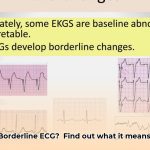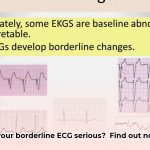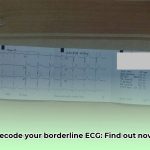Getting a “borderline” ECG result can feel unsettling, like seeing a slightly blurred photo where the details are unclear. It indicates minor irregularities in your heart rhythm, but whether they’re serious or simply normal variations isn’t immediately apparent. This informational article aims to help you understand what a borderline ECG means, potential causes, and, most importantly, the necessary steps to take next, promoting confidence and control over your health.
Decoding a “Borderline” ECG Result
Receiving a “borderline” ECG result can understandably cause concern. It suggests uncertainty about your heart health. Let’s clarify what this result indicates and how it impacts your cardiac assessment. An electrocardiogram (ECG or EKG) is a quick and painless test that measures your heart’s electrical activity. It can be used to check for heart problems or monitor existing ones.
Understanding That “Borderline” ECG Result in Detail
A “borderline” ECG isn’t a definitive diagnosis of heart problems. Instead, it signifies subtle irregularities in your heart’s electrical activity. While not necessarily alarming, these irregularities warrant further investigation. Think of it as a “check engine” light in your car—it signals the need for a mechanic’s inspection, not necessarily a complete engine failure. Variations in Heart Rhythm can create a borderline ECG. Phrases like “sinus rhythm with borderline ECG” or “unconfirmed borderline ECG” indicate that your doctor noticed something slightly unusual but needs more information to interpret it definitively.
Many factors can influence an ECG reading, leading to a borderline result. Stress and anxiety, faulty diagnosis, and dense breast tissue can all affect results. Lifestyle factors such as dehydration, or even excessive caffeine consumption can temporarily alter your heart rhythm. Some medications can also cause your EKG results to be borderline. Sometimes, the issue is as simple as improper electrode placement or slight body movements during the ECG. However, a borderline ECG might also indicate an underlying heart condition requiring closer examination.
What Could a Borderline ECG Possibly Indicate? Exploring Potential Heart Conditions
Several factors could contribute to a borderline ECG. Your doctor will carefully consider your medical history, symptoms, and ECG specifics. Here are some potential causes:
- Minor and Temporary Rhythm Issues: These often resolve without specific treatment.
- Electrolyte Imbalances: Problems with potassium, sodium, calcium or magnesium levels can affect heart rhythm and cardiac function. Even slight imbalances can manifest as borderline ECG findings. Correcting these imbalances is usually straightforward.
- Underlying Heart Conditions: Although less common, a borderline ECG may suggest a developing heart condition, such as a minor arrhythmia (irregular心跳). Conditions like early-stage arrhythmias or coronary artery disease might manifest this way. This is a possibility that needs further investigation to confirm or rule out. Further investigation is crucial. People with conditions such as hypertension, diabetes, or a family history of heart disease need to be closely monitored.
- Normal Variations: Sometimes, a borderline result reflects normal variations in heart function without clinical significance. Some individuals naturally have slight variations in their heart’s electrical activity. This is often harmless and does not require treatment, but it’s essential to differentiate it from potentially more serious conditions. Your doctor will consider your overall health to reach a conclusion. Conditions such as sinus arrhythmia (a normal variation in heart rate with breathing) or premature atrial contractions (PACs, or extra heartbeats), are often benign.
It is also essential to note that sometimes borderline ECG findings can occur due to technical factors rather than the patient’s underlying heart health. Technical errors include incorrect ECG lead placement on the patient’s body, poor skin-to-electrode contact and too much patient movement. Also, electrical interference from external devices may impact results.
Your Next Steps: What to Do Now After a Borderline EKG
A borderline ECG is a prompt for gathering more information, not a confirmed diagnosis. Here’s your action plan:
- Seek Immediate Medical Attention if Experiencing Symptoms: If you have symptoms like chest pain, shortness of breath, dizziness, or palpitations (a feeling of a racing or fluttering heart), seek immediate medical attention. These symptoms combined with a borderline ECG could indicate a more urgent issue.
- Schedule a Follow-Up Appointment: Don’t delay. Even without symptoms, it’s crucial to discuss a borderline ECG result with your doctor. Discuss your ECG results with your doctor as soon as possible, considering your complete medical history.
- Discuss Your Symptoms Honestly and Thoroughly: Describe any symptoms, such as chest pain, a racing heart, shortness of breath, or dizziness, no matter how insignificant they seem.
- Expect Further Testing: Your doctor will likely recommend additional tests for a clearer picture. These might include:
- Echocardiogram: An ultrasound of the heart that shows its structure and function. It can detect issues with heart valves or chambers. Uses sound waves to create detailed heart images.
- Stress Test: Monitors heart activity during exercise to assess its response to exertion. Evaluates your heart’s response to exertion.
- Holter Monitor: A portable ECG device that records your heart’s activity continuously for 24-48 hours (or longer), providing a more comprehensive view than a standard EKG. A portable ECG device worn for 24-48 hours to continuously record heart rhythm during daily activities. A portable device that records your heart’s activity continuously providing a more comprehensive view than a standard EKG.
- Blood Tests: Checks cholesterol levels, electrolyte balance, and other factors that can influence heart health. Checks for electrolyte imbalances or other issues contributing to the findings.
- Cardiac CT or MRI: Although less frequently used initially, these scans provide highly detailed images of the heart’s structure and blood vessels.
- Focus on a Healthy Lifestyle: While awaiting tests, maintain a heart-healthy lifestyle by eating a balanced diet, exercising regularly, managing stress, and avoiding smoking. Focus on a balanced diet, prioritize fruits, vegetables, whole grains, and lean proteins. Limit processed foods, sugary drinks, and unhealthy fats. Aim for at least 150 minutes of moderate-intensity or 75 minutes of vigorous-intensity exercise per week. Practice stress-reduction techniques like deep breathing, meditation, or yoga. If you smoke, quitting is one of the most impactful steps you can take for your heart health.
Weighing the Risks and Looking Ahead with Cardiac Monitoring
Your long-term outlook depends on the cause of the borderline ECG result. For many, it turns out to be nothing to worry about. However, it should not be ignored. Prompt evaluation and healthy lifestyle changes significantly reduce potential long-term risks.
| Factor | Short-Term Risk (within 1 year) | Long-Term Risk (3-5 years) |
|---|---|---|
| Underlying heart condition | Low to Moderate | Moderate to High |
| Electrolyte imbalance | Very Low | Low |
| Lifestyle factors | Low | Moderate |
| Technical ECG error | Very Low | Negligible |
Remember, a borderline ECG is often a prompt for caution, not panic. Proactive steps to understand your heart’s health will bring clarity and peace of mind. A thorough evaluation will help your doctor decide the next course of action. Did you know early detection can significantly impact managing heart conditions?
How to Interpret Borderline ECG Results and Next Steps for Heart Health
So, you’ve received a borderline ECG result. What now, regarding heart rhythm and cardiac function? It’s understandable to feel a bit anxious. Let’s break it down; It simply means the results aren’t perfectly clear-cut. They fall into a gray area, neither definitively normal nor clearly indicating a serious heart problem. Think of it like a blurry photograph – you see something, but you need a clearer picture to understand it fully.
Understanding the Uncertainty in Heart Rhythm Analysis
What causes this ambiguity in the electrical activity of the heart? Several factors can contribute to a borderline ECG. Technical issues during the test, like poor electrode placement or patient movement, can affect the readings. Even simple things like stress, caffeine consumption, or lack of sleep can influence your heart rhythm and vascular function. Underlying medical conditions, of course, are another possibility, but that’s what further testing aims to determine.
How to Interpret Borderline ECG Results and Next Steps: A Practical Guide for Patient Care
Your doctor plays a crucial role in interpreting your borderline ECG. They’ll consider much more than just the numbers on the printout. Your age, medical history, family history of heart disease, current medications, and any symptoms you’re experiencing all factor into their assessment. This holistic view gives them the context to understand what the ECG is telling them.
The next steps are crucial in clarifying the situation:
- Discuss with Your Doctor: Schedule a follow-up appointment. Describe any symptoms; chest pain, shortness of breath, dizziness, or palpitations are important to report.
- Further Testing: Your doctor may order additional tests. This could include:
- Echocardiogram: An ultrasound of your heart, showing its structure and function.
- Stress Test: Evaluates your heart’s response to exertion.
- Holter Monitor: A portable ECG worn for 24-48 hours, capturing your heart rhythm throughout your daily activities.
- Lifestyle Adjustments: While awaiting further results, focus on a heart-healthy lifestyle. Improve your diet, exercise regularly, manage stress, and limit caffeine. These changes
- Unpacking the Cost of Wellness Programs and Their Real Value - December 17, 2025
- How Much Do Wellness Programs Cost Businesses To Offer? - December 16, 2025
- Wellness Fair Ideas for Work to Boost Employee Wellbeing - December 15, 2025
















